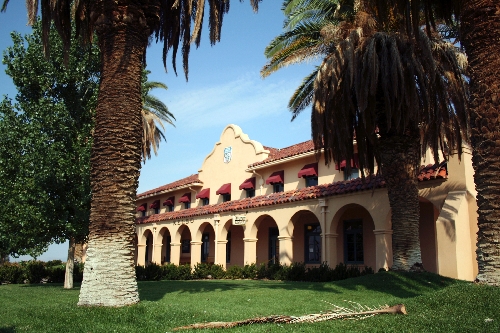Grab a bite and a bit of history at Kelso Depot

After driving dozens of miles of remote desert road through the 1.6 million-acre Mojave National Preserve, Californians are often quite surprised when they come upon the Kelso Depot. Here is a railroad station large and elaborate enough to serve a small city, sitting virtually in the middle of nowhere, at a tiny desert crossroad. It s not only one of the grandest buildings in the east Mojave, but it also serves as the primary visitor center for the preserve, has excellent museum displays and even offers a good place to get a light lunch.
This Spanish Colonial Mission Revival-style building was constructed by the Union Pacific Railroad in 1924. It was originally a workplace for general railway services; it also housed employees and offered dining for passengers and workers. It became a gathering place for the local population, which reached some 2,000 during World War II, many working as iron ore miners.
The area is all but a ghost town now. Once the railroad changed from steam locomotives to diesel, it didn t need to stop here for water, and the addition of dining cars to passenger trains ended most of the need to serve meals. While the restaurant and boarding rooms remained in use, the depot s busy years ended in 1962, and the Union Pacific closed it in 1985. It was even scheduled for demolition, but thankfully, preservationists learned of that plan and managed to halt it while seeking a better fate for the building that embodied so much East Mojave history.
The Bureau of Land Management purchased the depot in 1992 when the park was the East Mojave National Scenic Area. Two years later, the park service took it over as part of the Mojave National Preserve. Renovation began in 2002, and the depot was reopened to the public in the fall of 2005.
Quite a lot of historic research was put into the refurbishing. For example, restorers scraped down the paint to the original base coat, inside the building and outside, so they could match the colors. They found old photographs that showed the building in its original state and thus discovered that it had sported awnings. Based on this information, the outside of the building received a fresh coat of peach-colored paint and new burgundy awnings.
There are fine displays on mining, ranching, human history, wildlife and geology here. One of the best places to learn about the railroad history and the Union Pacific Railroad is on the second floor. Here you will find two completely restored employee rooms that are set up as they might have been more than half a century ago. They come complete with the roar of actual trains, which don t stop there anymore but pass just a few yards away about once an hour. For the best train-watching thrill, just step outside the depot s front door and walk up to the safety fence.
Since the depot serves as the park s primary visitor center, this is the place to pick up maps and hiking information, ask a park ranger any questions you might have or maybe enlist your children in the Junior Ranger Program. There also is a very well-done, 12-minute orientation film. The staff offers Kelso Depot Talks at 11 a.m. and 2 p.m. Monday through Friday year-round. These ranger-led programs last about 20 minutes and delve into the natural and cultural history of the park. The depot is open from 9 a.m. to 5 p.m. daily.
Plan on spending at least an hour at the depot to see the exhibits, browse the bookstore and have a bite to eat at the lunch counter. This time of year, Kelso Depot s lunchroom, The Beanery, is open from 9 a.m. to 5 p.m. daily. While the menu might be subject to change, when I visited a few weeks ago, it was serving three types of salads, four different sandwiches, hot dogs, milk shakes, ice cream, pie, brownies and a variety of soft drinks.
Deborah Wall is the author of Great Hikes, A Cerca Country Guide and Base Camp Las Vegas: Hiking the Southwestern States, published by Stephens Press. She can be reached at deborabus@aol.com.
DIRECTIONS TO KELSO DEPOTFrom Las Vegas, take Interstate 15 south for about 50 miles. Exit onto Nipton Road and go east 4 miles. Take a right onto Ivanpah Road and drive 3.1 miles. Go right onto Morning Star Mine Road and travel about 15 miles to Cima. Here, the road turns into Kelso Cima Road at the railroad tracks. Continue for about 19 more miles on Kelso Cima Road to the Kelso Depot.












